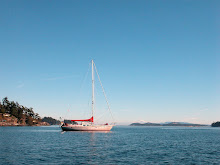
The west side of Edgeoya was spectacular and unpredictable. Shortly after arriving it began to rain. The rain quickly turned into sleet and settled as snow at higher elevations. By midnight the snow was fifty meters from sea level but the morning sun melted all traces of winter’s brief appearance.
Unusually little swell allowed for an easy beach landing and we were able to explore the area. From lush green terrain to basalt cliffs and flat rock with fossils, the landscape varied throughout our hike. On top of the mountain we found a tripod with scientific instruments and six ptarmigan, almost invisible in their brown summer plumage. There was no haze and we had a clear view of the glaciers and ice caps thirty-six miles away on Spitsbergen’s east coast.
On the way down we encountered two curious reindeer who showed no sign of being disturbed by us. In between mouthfuls of grass they wandered closer. Their antlers were still covered in velvet and they were close enough that photographing with a macro lens was not a disadvantage.
The following day the wind started to pick up and by the time we decided to put more anchor chain out, it was blowing fifty knots and our anchor snubber had snapped from the force. On deck it was difficult to see and impossible to communicate. The wind drowned out our voices and the spray felt like sharp needles on our minimally exposed skin. In the process of letting out more scope, we destroyed our anchor windlass motor. Which meant that until we got back to civilization, the anchor would have to be pulled manually.
Quest, an expedition ship came into the anchorage next to us, we called them on the radio and asked if they had a weather update. They informed us that wind would drop later in the evening and the captain recommended that we not move as there were 2.7 meter seas once outside the shelter of the island. The weather fax that we pulled in listed no gale warnings even though we had over forty-five knots of sustained wind. After thirty-six hours of strong wind and little sleep, conditions began to improve and we were able to get the dinghy on deck in preparation for moving. Our anchor was holding but the violent snatching made it impossible to sleep until the wind reduced to a sensible level.
We left Edgeoya with the intention of going to Hornsund to visit the Polish Research Station before heading back to Norway. While Snow Dragon bobbed off the tip of Spitsbergen in little wind, we pulled in a weather fax and noticed good conditions for crossing the Barents Sea. It was now the end of August and solid weather windows were becoming rare. Though it would have been nice to see our friends at the Polish Research Station, we were not about to pass up the opportunity to cross the Barents with favorable wind.
For more photos of Edgeoya please click on Edgeoya Album.




















